
(Photos © J. Maus/BikePortland)
What is it about bicycles that inspires Portland’s residential real estate developers? First there was Milano, then Velomor, and now there’s the Peloton Apartments.
“Our apartment project caters to the biking community.”
— Gus Baum, Security Properties
Saturday night while biking by the construction site on the block bordered by North Williams, Skidmore, Vancouver and Mason I noticed a new banner. I had to pull over and stop when I saw the word “peloton” and the sign with a design that included dozens of cute little bikes.
Just last week I was talking with our news editor Michael Andersen about how bicycles are such a common symbol in many of Portland’s recent apartment and condominium projects. If not in the name of the building itself, bicycle-inspired graphics can often be found on the signage and exterior decor of many of the new buildings sprouting up on Portland’s skyline.
It’s not surprising that bicycles figure into developers’ plans. After all, bicycling is arguably the most well-known brand attribute of Portland these days (with craft beer and the food scene rounding out the top three). Heck, even out-of-town sportswriters find ways to mention bicycling in completely unrelated stories.
In the case of the Peloton Apartments, the developer of the 268-unit project says inspiration for the name came from being located on Portland’s busiest bicycle corridor.
Gus Baum of Security Properties shared with us via email this morning that, “Since inception, the Peloton site was focused on taking inspiration from the unique community on N. Williams, and in particular the bike gateway to the city via Vancouver headed south and Williams headed north.”
“Literally hundreds of avid bicycle enthusiasts,” Baum continued, “from commuters to casual riders use the thoroughfares to navigate to north and northeast Portland every day. We wanted our multi-family apartment project to embrace not just the two major streets surrounding our project but to bike culture in Portland overall.”
Advertisement
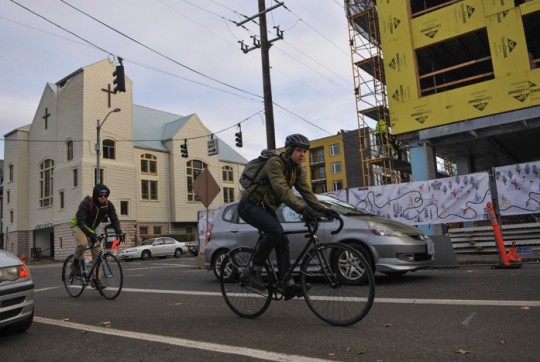
What’s more, Baum says the color schemes of some units were inspired by a popular racing bike and some doors in the project will match the color of vintage yellow jerseys from the Tour de France.
The word peloton comes from the French “platoon” and today is used to refer to the main group of riders in a bicycle race. Baum is likely unaware of the irony of using a name from competitve cycling for a building on streets where high-speed bicycle riding — also known as “Cat 6” or “hipster racing” according to the Urban Dictionary — is rampant and often ridiculed.
Thankfully bicycling will be more than just part of the origin story at Peloton Apartments. As we reported last year, the four-building development will include a “pedestrian-focused” woonerf space. Baum says bike-loving residents of the Peloton will also enjoy 275 bike parking stalls, a bike club, and “numerous connections to Portland’s bike community through artwork, branding and other gestures.”
The banners visible today on the fence around the construction site are part of that branding effort. They were designed by Portland-based OMFG Co.
The Peloton Apartments are just the latest in the ongoing transformation of North Williams Avenue. What used to be a place that housed half of Portland’s black residents has changed drastically in the past decade and bicycles and the people who ride them have been at the forefront of that change.
— Jonathan Maus, (503) 706-8804 – jonathan@bikeportland.org

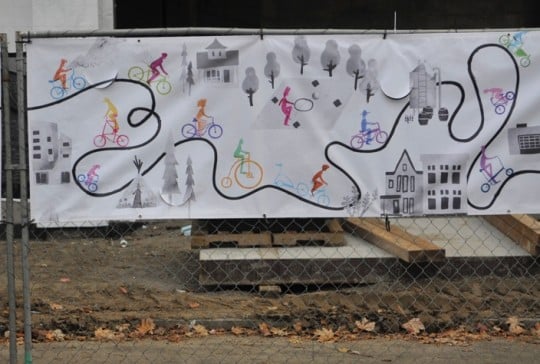

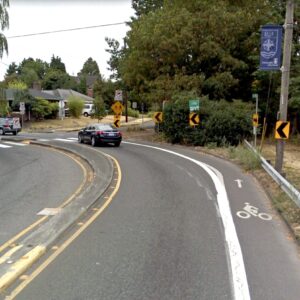
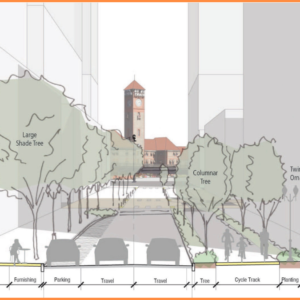
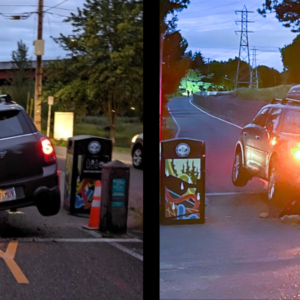
Thanks for reading.
BikePortland has served this community with independent community journalism since 2005. We rely on subscriptions from readers like you to survive. Your financial support is vital in keeping this valuable resource alive and well.
Please subscribe today to strengthen and expand our work.
A 268 unit apartment complex has bike parking for 275 bikes. That doesn’t sound like much for a building appropriating bike iconography as a marketing strategy. How many bike-oriented households have more than one bike?
Yeah. Plus what happens when friends/guests come over? Do you tell them to park outside or at New Seasons?
If the building is full of typical cyclists, it’ll need parking for abut 1200 bikes (n + 1).
Um…, I park my bikes in the living room.
It’s too cold to leave them outside.
If you’re cold, they’re cold.
I put a blanket on mine to help it keep warm.
..and wouldn’t consider putting most of them in a shared space, even if it *was* locked and on security cameras.
While I take this as a humorous point on the obsession of some people with multiple bikes, the “typical cyclist” is not actually the person who owns multiple bikes, but the person who owns one, and tends to have less than average income.
BikePortland readers aside, that’s the average.
http://bikeportland.org/2014/01/30/biking-matters-most-to-lowest-income-local-households-new-data-shows-100713
See also.
https://www.washingtonpost.com/news/local/wp/2015/11/12/why-are-bike-lanes-such-heated-symbols-of-gentrification/
Of course, the typical cyclist in a cycling-themed new apartment may be different.
Does the typical cyclist live with another typical cyclist?
More likely than the non-typical cyclist.
But 48% of apartment dwellers in the U.S. are the only person in them. http://nmhc.org/Content.aspx?id=4708
I don’t have Portland-specific numbers handy.
Ugh. My bad.
48% of apartment households have only one member.
Even if we assume all households have either 1 or 2 members in them, with the proportion you describe, and all household members are typical cyclists, that leaves a huge shortfall of bike parking.
If we further allow that some of the members of this cycling themed building are in fact atypical cyclists (who, as you suggest, may not attract a mate, but will have more than one bike), the shortfall is even greater.
And then there’s always that dude who has, like, 8 bikes.
So… not nearly enough bike parking.
The developer has an incentive to get it right. Looks like 275 bike parking spaces for 268 units.
Presume 5% vacancy rate = people in 255 units. Presume half of those are one-person units (127), fifteen are three person units (45), and the rest are two person units (255). That’s 427 people to be served. The developer is betting having a single bike parking place for 64.4% of people is sufficient.
[Plus visitors — it’s not clear whether there’s exterior bike parking, which is more aimed to visitors.]
And some people (who have lots of bikes) may store extra bikes in storage units or their apartments instead of the bike storage area. But for their every day commuter bike, providing a spot for nearly two-thirds of people seems like a good estimate for a very healthy, bike-focused development.
But if they don’t, they can convert other areas into more bike parking.
OTOH, note that while it has capacity for 275 bikes, it only has 50 car spaces. For a 268-unit complex, that’s pretty much a win.
Not if you want to park the 276th bike.
I guess we now have N+1, S-1, and P+1 in our bike math 🙂
Wait, I know the N+1 and the S-1 but P+1?
P+1 is having one more bike than the (275) parking spaces.
It’s only a win if people who don’t own cars move into the place. If the typical lessee owns a car, it will mean the city is just subsidizing parking to beef up the bottom line for another developer.
I don’t mind businesses without sufficient parking; they tend to boost the local neighborhood. Homes are a different question. Unless the landlord makes not owning a car a condition of living there (unlikey), then this will just exacerbate the parking situation that is already pretty bad in that area.
I realize it is a cart/horse problem….
Stph
It shouldn’t be the landlord’s job to check for auto registrations. The city should stop giving away a valuable resource for free and the rest would sort itself out. Please consider sending your support for a new parking permit program as is being proposed currently:
https://www.portlandoregon.gov/transportation/63980
It actually has over 200, according to NextPortland and the permitting info. There are 50 commercial spaces and then like 185 residential, which is actually way more than the code required. You can technically build an apartment building with zero car parking along the Williams/Vancouver corridor.
Ted Timmons wrote:
” it only has 50 car spaces. ”
Not true — the entire block is a basement parking garage, I suspect the actual car parking count is more like 250 spaces.
I’m on the neighborhood association, so saw the plans, but it was a while back and I don’t recall the numbers.
Ted Buehler
ah- ” 50 stalls dedicated to ground floor [retail]”.
followup: “237 vehicle parking stalls will be located in the basement, split between 52 spaces for the commercial uses and 185 for the residential uses.”
http://www.nextportland.com/2015/04/29/peloton/
Given that city code is 1.1 bike parking spaces per unit (and they do check during plan review) either the unit count or the bike space count is wrong.
“A 268 unit apartment complex has bike parking for 275 bikes. …” kitty
Not bad, if most of the 275 bikes actually wind up being used for commuting and regular recreational riding…at least something more than collecting dust down in the bike storage room.
How do you feel about cars that don’t get used?
Good question. More relevantly posed, might be:
‘How do personal motor vehicles not regularly used, meet people’s travel needs, as compared to bikes not regularly used?’
For many people, even if for no more than occasional use, personal cars can do what they need, better, I think. And, I think most people, not just myself, today, in general, feel the same way. There may be more people today embracing the idea of bikes as personal, practical transportation, but I think many of them still likely feel that a personal car is very nice to have in addition to the bike they may use frequently for meeting practical travel needs.
If there’s not strong indication of need from the market for their building’s apartments, for bike parking rather than personal car parking, from a dollars and cents perspective, landlords will have to prioritize parking for personal cars.
Sure, if they do.
We have a similar apartment complex built several years ago here in Boulder CO called Peloton, too. It is much more about the marketing than anything else. Boulder is also a bicycle lovers dream community. But I see no more cyclists trekking out from this building than cars or transit riders. Good idea, but it is still just a label.
But are the developers along Williams creating an expanded LID to fully fund the build out of safe bike facilities on Williams and Vancouver? The LID should include PCC/Cascades, Emanuel, New Seasons and the Blazers.
My old landlord really shortchanged himself. That apartment wasn’t facing the alley and dumpster divers, it was a woonerf with people watching.
“‘Peloton’ apartments on Williams-Vancouver corridor take inspiration from huge piles of cash”
Hi Jonathan,
I fixed the headline for you.
A rendering with zero biking infra in the rendering main page…check!
Well, perhaps..this building will motivate PBOT to put protected lanes without lanes in the door zone on both Williams and Vancouver.
Perhaps.
AFAIK, there are no door zone bike lanes on Williams. Vancouver Ave however does.
Williams just north of Fremont still is, and I’ve nearly been doored in it twice.
Ah, that’s the one spot that remains door zoned. Unfortunately PBOT went with that design for that one block due to maintaining traffic flow from the signal on Fremont. Not a big fan of that treatment myself.
Too bad there is no safe bicycle infrastructure anywhere near the new apartments.
I have bike commuted the Williams-Vancouver corridor for 6 years and I’ve never felt unsafe. Maybe try rodney if you feel threatened.
I find Williams & Vancouver to be mostly safe having ridden them almost daily for 7 years, and then there’s Rodney and Going also nearby which are more family-friendly.
I caught this on the bus, and had a good laugh all the way to work. Developers seem to create the most fallacious names for their work. Has one ever seen a subdivision title that met the geographic surroundings it came to occupy ?
They’re usually named after something they destroyed to build the development. “Grand Firs” are clearcut, “Clear Creek” is run under a culvert…
“Developers seem to create the most fallacious names for their work. Has one ever seen a subdivision title that met the geographic surroundings it came to occupy ?”
Um, this one would be your exception.
I just waited at least a minute to cross Williams at Failing at 5:45 pm, the bike (and car) flow was almost constant. & this is the last week in November, statistically the rainiest week of the year.
Ted Buehler
Sorry Ted, I don’t see it that way. I find the misappropriation of the race specific term to be inane at best. The author of the post pointed out the Williams and Vancouver cat 6 irony as well. It doesn’t really matter… Maybe the marketing agent of “peloton”, is making a joke about the “mass group” of movement within their industry to transform Portland into unaffordable for many who love cycling here? Lord knows I can’t afford it anymore.
Sounds like you’re in danger of being displaced, as the significant black community was that called that area home not that long ago. “Transformation” and “forefront of change” have such happy connotations, if you’re the beneficiary. The wheel keeps turning.
Ha! Assume away! I’ve been here 13 years, and people were screaming g this then, and before. I was raised in a community with 29℅ more African Americans than Portland. I have lived in zip codes with some of the highest murder rates in the U.S.. I do not live along Williams. And just FYI… I now livein a van. Thank you very much.
Guess I assumed that you are in danger of being displaced because you said you can’t afford it any more. If living in a van keeps you from being displaced, then good on you. Where you have lived before is not relevant to my point.
The relevant tie, is your mentioning the displacement of an entire community. My former home in tandem with Portland were structured and developed with the same redlining in regards to race. That is another conversation, for sure. The fact remains, that dispute color, or locale many of my friends in similar economic terms are struggling here. Three of my coworkers ( one with a spouse) are preparing to reside in vehicles just as I have been forced to do. Two of them have lived here or a decade, and are bike commuters. I have a child in middle school. I lost my last two rental rooms to airbnb scenarios. This former home racer won’t be signing a lease at peleton anytime soon. Peace.
Sorry about the spelling… Big thumbs, little Android keypad..
My suspicion is that Airbnb is consuming a lot of lower priced semi-formal housing (i.e. a room in someone’s house, downstairs apartment, etc.). Does anyone have any data about this?
I think we share some of the same frustrations. My point, perhaps not very well stated, was that some of the changes so often praised here on BP are not always good for everyone. I didn’t see that being recognized in all the comments about how many bikes one should own or where they should be stored. I wish the best for you and your middle schooler.
Whatever marketing person came up with that name and theme is clueless about bicycle culture in Portland.
What apartment name would best capture Portland bike culture?
Dunno. “Cage-Free”? Ha ha. Anyway, the sport of professional road racing certainly has very little connection to Portland bike culture.
bikesnob uses peloton to describe cat 6 racers and i think it works very well here as well.
The Smugoton? Smug Valley? Smug Acres? Bakfiets-Woonerf-Huis?
“WATCH YOUR LINE” or “STRAAAAAAAVAAAAAAAA!!!!!!!!!!!!!!”
There is the Eastside 101 apartment complex on SE Chavez just south of Stark. They use a bicycle rider graphic as the main design element of the building logo; it’s on all the doors and signs. They have no guest bike parking at all in the parking lot behind the building, or anywhere in a several block radius, and access by bike is really difficult since they are on Chavez and there is no back or side entrance. But hey, they stuck a bike on the sign, so they’re obviously bike friendly. Yay!
“inspired by a popular racing bike”
uh, which bike? I assume it’s one specific bike, but I have no idea which one it would be.
Steve Bauer’s Roubaix bike? I hope.
The thing that gets me with this development is how much their contractors have impacted the commute. Stopping car and bike traffic during the morning rush hours, telling their delivery trucks to park in the bike lane while they wait to unload, their fences taking up sidewalk space for however long it’s been under construction…..
No doubt developer’s mouths are watering eyeing the church across the street and planning it’s demolition, and the empty lot across the street from that. That whole Skidmore/Williams/Vancouver area has been hell during all this construction. But hey we gotta keep those cheapo apartments coming.
“Cheapo apartments” aren’t very cheap, and increasing supply is pretty much our only choice. See also: Seattle vs SF.
Does one of those cities have cheap apartments?
Seattle’s apartments are much cheaper than San Francisco’s, and Seattle also has allowed much more multifamily units to be built than San Francisco in proportion to population.
Compared to San Francisco, everywhere is cheap. Seattle is not a good example of low rents.
Seattle has built a ton of apartments. It has pushed rents down. SF hasn’t. (see Monday’s roundup)
That article notes two things: the rate of increase of rents has slowed in the last year, to “only” 4-8%, and that builders/landlords are a bit unnerved by that slowdown, which will likely lead some to stop building housing and invest elsewhere.
I fully expect all the new units that are coming online will slow recent upticks in rent; but what we really need are more lower priced units.
Except that article is absurd parroting of claims made by the local government which is in the pocket of the developers building low quality high rent apartments and micro apartments all over town, knocking down existing affordable housing to do so. (see past claims that developers have to provide an alternative to just closing the sidewalk for their building projects – another lie). Rents all over the city are going up between 10-40% annually and it will only slow when the people driving this change – those making >$100,000 annually – start to see the pinch when average rents start going over $3k / month.
Instead of complaining about the people that are adding housing to Portland, you could start a company that builds inexpensive new apartments. But good luck outbidding them when another big lot becomes available.
This is how housing works. New things are not cheap. Dumb people buy shiny new things and lose money on them, and then smart people buy them second-hand. Expecting brand new, affordable apartments is unrealistic.
I’m not complaining about that at all — I just think the solution to high rents isn’t the market based build-your-way-out solution that some here suggest. Developers will stop building when they think we’ve hit a peak (and renters will hope they misjudge and overshoot).
As for the second-hand market, it seems that, if anything, things are going the opposite direction, as older buildings are renovated to support higher rents.
I don’t believe there is a problem at the top end of the market — the real shortage is at the bottom end. And, as you pointed out, no one is building there. One answer might be small units, which will have a natural upper limit on rent, but, as you suggested, I’m not a builder, so I don’t really know.
Actually, that’s not true. I do complain about the poor design that characterizes many of these new buildings.
Seattle *in the past few decades* has allowed many more multifamily buildings to be built. It’s still more low-rise than San Francisco in total I’d bet, but not by much…
I’m guessing he meant poorer quality.
When will they build the Tigard apartment complex: Gas-guzzling gridlock?
Hopefully they design it so getting in and out by bike is convenient.
cat 6 is not high-speed bicycle riding; rather, it is silly commuter racing.
the origin of the term was here:
http://www.bikeradar.com/forums/viewtopic.php?t=12575770
typically, the commuter be a) does not know they are in a race, b) is simply traveling at their normal speed, and c) could not care less in any case.
correction:
typically, the commuter being raced a) does not know they are in a race, b) is simply traveling at their normal speed, and c) could not care less in any case.
it’s the mechanical rabbit principle at work.
Just because no-one else knows it’s a race doesn’t mean you aren’t winning!
Looks like this article hit BikeSnobNYC: http://bikesnobnyc.blogspot.com/2015/12/hovding-and-angry-inch.html
heh.
Ha, about as much cycling inspiration as the Trek Edition VW Jetta, or the Hundai Veloster. I predict 257 empty bike parking spaces and another “surprise” battle over a “sudden” lack of car parking around this Peloton building.
There’s not much difference between ‘low income’ housing and market rate housing insofar as construction costs. Figure $170-$210/sq ft. Market rate may have more expensive finishes, but the basic costs are similar. The major difference is the funding sources. A lot of low income housing is subsidized in order to offset the losses the developer would face by not charging market rate prices. Any project that gets public money also becomes a prevailing wage job which can increase construction costs immensely.
We’re building some awfully small market rate units currently, I don’t think less square footage create an upper limit as long as there’s demand. They’re certainly not designed for families, maybe not even for couples.
Subsidized OR required by law in places with inclusionary zoning…
Unfortunately, even the city’s new proposals for incentivizing affordable housing only require the developer to pay into a fund, not actually offer any lower cost units.
>Hello, Kitty
>As for the second-hand market, it seems that, if anything, things are going the opposite direction, as older buildings are renovated to support higher rents.
>I don’t believe there is a problem at the top end of the market — the real shortage is at the bottom end.
It’s a knock on effect. There aren’t enough new units at the top end, so some people who could afford rent or purchase of a new apartment are living in an old one. The cost to renovate isn’t that huge, at least when it’s limited to the most visible items, like a new floor, counter, or fridge. If you want those old buildings to stay in rough shape so that there is more variety in the housing stock, including options at the bottom end, then you want the top end saturated. Either by reducing demand or by increasing supply. Absent strict controls (rent control?) the problem at the top end will be solved by causing one at the bottom end.
There is an added complication though. There isn’t much difference between renovating an old building and knocking it down to put up a new one, unless the new construction is much larger. All else equal the buildings in the worst shape serving the bottom of the market are most likely to be the best bet economically to be knocked down for new construction. Right now in much of the city prices are well in excess of construction costs excluding land. You can get at some of that land value with added regulations without reducing construction levels much. If you use zoning to encourage/require those new buildings to be larger and reserve some units for those with limited incomes you can help make up for the loss of lower end housing stock. We generally require those new buildings to have parking to minimize the knock on effect it would otherwise have on housing for cars, why not do the same for people.
The people I know with cheap(ish) rent aren’t looking to pay more by “upgrading” (especially to one of these newer buildings), even though they could afford to. They want to keep their rent low in hopes of saving enough to buy a house (or pay off debts). So I don’t buy the notion that if there were more high-end apartments available, people with low rent but high incomes would snap them up, freeing the lower end units for someone else.
But there are lot of new units coming online soon, so maybe we’ll find out that I’m wrong. I hope I am.
We’ll probably have a longer wait to see if inclusionary zoning can/will work, as there seems to be no political consensus in Salem to allow it. The city’s proposed incentive program seems to be rather anemic.
My child in 6 the grade will more than likely be graduating before we know that answer. 😂
About 4300 units are being permitted each year in Multnomah County. Maybe this can accelerate to 5000 or 6000 or 7000. I don’t see it going a lot higher. Developers, or rather the banks, have painful memories of the last housing boom and bust. No-one wants to be the next South Waterfront. They are wary of over extending.
Add house demolitions and ADUs, maybe Portland can add 6000 to 8000 units a year. How many people moved to Portland last year – over 30,000?
I think there is no quick fix to the housing shortage and rising rents in Portland, until the boom stops and busts.
I would keep an eye on San Francisco. That is the epicenter of the tech boom, which is probably the single biggest driver of Portland’s current growth. When funding starts getting tight for money-losing tech startups, when startups aren’t being bought by larger companies so quickly, when IPOs start falling flat, when the SF tech bubble starts deflating, then Portland’s surge of growth will slow and reverse.
It wasn’t so long ago that Portland lost 11,000 jobs in one year, unemployment was >10%, vacancy rates were high, and rents were cheap. 2010, I believe. When that happens again, we’ll get falling rents and vacant apartments again. As well as rising unemployment, money getting scarcer, and people bicycling from sheer economic necessity. Be careful what you wish for . . . you might just get it.
Until then, the search for low rents will lead to points north, east and south. The cheap apartment in close-in central Portland will keep getting scarcer.
I’d like to add that not all those new arrivals will want/be able to afford a high end unit, adding even more competition for those cheaper units that are available.
I’m even more curious what we’re going to do with 3-4 million or so California refugees (assuming we only see about 10% of them) when the drought really settles in down there…? If the paleoclimatologists are right and the past 100 years of development occurred during a particularly wet season, then we can expect some rather drastic migrations of the herd before too long.
http://www.nytimes.com/1994/07/19/science/severe-ancient-droughts-a-warning-to-california.html?pagewanted=all
Stph
Something like 85% of California’s water consumption is for agriculture which produces something like 5% of the state’s GDP and employs a similarly small portion of the state’s population. California could
cut back on a few particularly water-intensive crops (almonds, rice, alfalfa) and save water equal to all the residential water consumption (drinking, washing, cooking, lawns, swimming pools, everything) of the entire state. The impact to the state’s economy would be minimal.
California is in a meterological drought, no question, and the impacts on wildlife, forests, etc are serious. But as far as human water needs go, California’s drought is only a problem because the state’s laws and institutions allocate, price, store, and distribute water in an illogical and outdated manner. Which, to be fair, is not much different from how it is done all over the West, including in Oregon.
Long before Californians choose to evacuate their state due to water shortage, they will reform their system of water rights and controls, which will hurt some farmers but otherwise will solve their water shortage. There will not be a mass, Grapes of Wrath style exodus of parched Californians to Portland.
There are merely cyclical periods of migration by a relatively small number of Californians to this city. Remember there have been other periods when it was in vogue for Californians to move to Portland. The early 1990s was one such period, lots of my friends in L.A. moved up here; most returned to California a few years later, disillusioned by the poor job market and the backward – nay, primitive – culture outside of Portland city limits (to hear them put it). These periods seem to coincide with real estate booms in California. There was another in the mid 2000s. What is going on now is not as unprecedented as some might think it is.
As climate change makes Oregon warmer and drier, this state will become more attractive, to the average person who doesn’t actually like constant rain. That’s unfortunate. But it will be gradual and not limited to Californians.
Almonds, once a luxury are now omnipresent. This issue has bugged the crap outta me for years. Eat less almonds!
The idea that nuts or vegetables are a significant issue in california is pure mythology.
http://www.nytimes.com/2014/03/08/opinion/meat-makes-the-planet-thirsty.html
Grown on over a million acres in California, alfalfa sucks up more water than any other crop in the state. And it has one primary destination: cattle…
If Californians were eating all the beef they produced, one might write off alfalfa’s water footprint as the cost of nurturing local food systems. But that’s not what’s happening. Californians are sending their alfalfa, and thus their water, to Asia…Alfalfa growers are now exporting some 100 billion gallons of water a year from this drought-ridden region to the other side of the world in the form of alfalfa. All as more Asians are embracing the American-style, meat-hungry diet.
The single best way to reduce diet-linked water use is to become a reducetarian or veg*n.
Please investigate almond production growth in the past 20 years. Im well aware of cattle and and the problem it brings. I am a chef of 42 years, and have been involved in “slow food ™ long before it was coined as such. Please don’t escalate my light hearted jab at almonds. Do you have a domestic house cat ? Let’s speak to its contribution to global warming.
in terms of total “blue water” usage almonds are a drop in the bucket in comparison to meat and dairy.
http://www.businessinsider.com/real-villain-in-the-california-drought-isnt-almonds–its-red-meat-2015-4 (the graph only shows the impac of forage and not the other water use associated with meat/dairy production)
I have no problem with alfalfa, beef, or exporting to China. What I object to is the distortions caused by grossly mispricing natural resources. In California, some people (certain farmers with senior water rights) get water at extremely low prices. Other people (with wells) get water at low prices, basically just the cost of running the pump. Others pay high prices for water (buy it on the open market or get it through expensive contracts).
Water is a valuable public natural resource and should be priced as such. If water is priced appropriately, then if a farmer still finds it profitable to grow alfalfa or almonds, then that’s fIne. And- more likely – if a farmer can’t profitably grow almonds or alfalfa and is forced to raise his prices or switch to a different crop, and consumers pay more for almond milk and beef, that’s also fine. Let the price of water reflect its true value and much of the gross wastage will stop.
Tangentially related, have you read “cadillac desert”?
Hey John. Just some perspective from an old man. When I was a child, almonds were NOT readily available year round. In my grandparents day, beef was NOT on the family menu 4-7 times a week. Despite our post cold war obsession with the iconc hamburger, the primary red meat consumed by European immigrant family in the U,S., was rabbit. Not until the mid 40’s did the average American start to enjoy prime cuts with any true leisure. I once catered an event on a private train that carried President Lincoln. On the trip we recreated his formal meal, with firewood stoked stoves. There wasn’t one beef course on the menu.
Soren, has not taken my prodding to get to the true dark underbelly of the issue with almonds. One would have to be living in a l hut somewhere not to know about the problem surrounding water and cattle.
Almond production in California is 86℅ higher than in my grandmothers day. So much so that it requires 70℅ of the managed bee population in the US to pollinate it. Truly beyond luxury, even for all of us at this time, IMO.
Peace.
almonds are a rounding error and reporting on almonds was motivated by omnivore butthurt rather than true concern about our shared environment.
PS: meat, dairy, and california almonds are luxuries that i have been avoiding for many years.
Will these millions be coming all at once, or, say, over a period of 100 years? That’s the difference between deploying tanks and barricades across the highway, and the influx we have today.
But I think John is right… Californians will sooner give up their alfalfa than their homes.
It is dumber than that. Much of that alfalfa doesn’t go to Californians at all. It is loaded in shipping containers and shipped to China for its dairy farms. It can get shipped cheaply because the shipping containers are going back anyway, and would otherwise be empty. California is in effect exporting water, very cheap water.
http://www.latimes.com/business/la-fi-feeding-china-hay-20140609-story.html
its a marketing gimmick — they know that if you are NOT paying 80 bucks a month for insurance + 40 for gas…
they can jack up the rent another 120 per month – and you will pay it